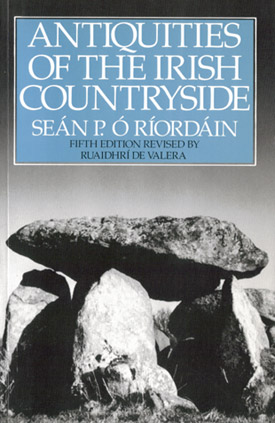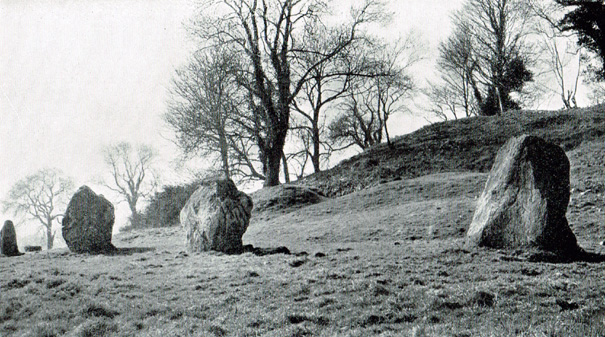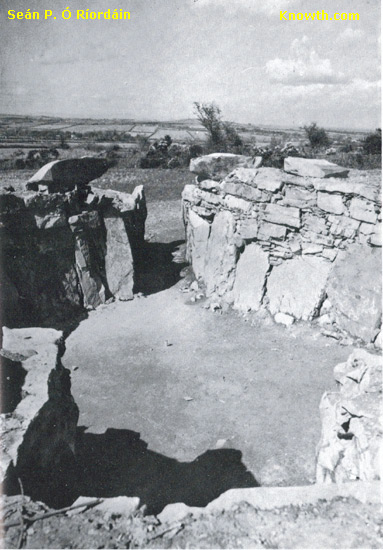Antiquities of the Irish Countryside
 Antiquities of the Irish Countryside by Seán P. Ó Ríordáin.
First Published in 1942, Fifth Edition 1979, revised by Ruaidhrí de Valera.
Antiquities of the Irish Countryside by Seán P. Ó Ríordáin.
First Published in 1942, Fifth Edition 1979, revised by Ruaidhrí de Valera.
From the preface to the First Edition (Cork University Press, 1942)
This booklet is not intended for specialists in archaeology. Its purpose is to give some answer to the questioning man in the street, who asks the archaeologist for a simple explanation of some monument which he has noticed in the countryside and which is, in all probability, a typical example of a class of antiquity widespread throughout Ireland.
The question usually concerns an individual structure, be it fort, souterrain, stone circle, or other antiquity, of which the archaeologist, lacking evidence which excavation might yield, can say little. He can, however, explain at some length what is known of this type of monument.
Purchase at Amazon.com or Amazon.co.uk
So that such information may be available in a convenient printed form it is proposed to give an outline here of the present state of knowledge concerning those classes of antiquities most frequently met with in the Irish countryside, and it is hoped that our brief notes will make them intelligible to the inquiring layman. Monuments, (churches, high crosses, round towers, and so on) belonging specifically to Early Christianity are not dealt with here, since their study involves the subjects of architecture and art rather than archaeology proper, and it is proposed to confine our survey to the types of monuments most common throughout the country.
Since this booklet is for the general reader, who may have no ambitions or opportunity to delve deeply into the voluminous archaeological literature which might be invoked on each of the topics covered, it is not intended to encumber the text pages with references. Should the reader wish more fully to acquaint himself with the subject, the Bibliography at the end may be found useful. With the aid of this, he should be in a position to evaluate for himself the evidence produced by excavation and by field surveys.
It is the hope of the writer that, having read the pages that follow, the reader may be stimulated to seek for himself examples of the antiquities therein described. Should he wish to do so, he is strongly advised to procure for himself a copy of the 6-inch Ordnance Survey Sheet covering the district in which he is interested. The maps are invaluable and must serve as the basis for any proposed Field Survey. While on some sheets the sites of almost all monuments are recorded, on others the omissions will be found to be numerous, this being particularly true of mountainous areas. The enthusiast with a flair for field work can do immense service to archaeology by undertaking an accurate survey of all the ancient remains in some one district. Such a survey calls for detailed plans and descriptions of all sites, whether recorded by the O.S. or not. Its careful compilation will, in many instances, bring to notice monuments unknown to Irish Archaeology, while it should, in any case, serve to make more complete our still very inadequate knowledge of field antiquities particularly in the matter of the distribution of the different types.
Preface to the Fifth Edition - 1979
More than a quarter of a century has elapsed since the late Professor Seán P. Ó Ríordáin completed the third edition of his Antiquities of the Irish Countryside. Throughout that time it has admirably served its primary purpose of informing 'the questioning man in the street' as its author himself had intended. It also proved to be a valuable synthesis for students of Irish archaeology as the success of the fourth edition as a University Paperback so amply showed.With the passage of time as Seán P. Ó Ríordáin himself anticipated, new discoveries and advances in archaeology inevitably called for additions and alterations and it is the purpose of the present edition to meet this demand. The task has been made more onerous and at the same time more interesting by the expansion of Irish archaeological work during the last twenty-five years, in the fostering of which Ó Ríordáin himself played such a major role.
In preparing this edition I have sought to retain the original author's approach and many passages of the text remain virtually unaltered. The chapter arrangement follows his save that the sections dealing with Fields, Roads and Linear Earthworks are taken out of the chapter on Forts to form a new chapter of their own. Since the field antiquities reflect, in many cases, episodes in the story of Ireland's past I have added an Introduction which seeks to synthesize these episodes and relate the various monument types to them. In doing so an attempt is made to see the monuments and the episodes with which they are connected in a geographical setting and see the societies who built them as real people, however shadowy and uncertain the picture may often be. Such an approach is, of course, not new but as one works through the various stages of the story it becomes clear that it has been very unevenly attempted as yet in Ireland.
For many episodes opportunities for the exploitation of this approach are manifest through such techniques as detailed mapping, soil and vegetation studies etc. The recognition of natural regions and barriers and their effect on settlement can yield useful results. The regions occupied by different groups can tell us a good deal about economic requirements and the capabilities of the various groups to exploit and sometimes alter their environment. The effect of other contemporary groups on the extent of settlement, however difficult to assess, cannot be ignored. In the present state of knowledge conclusions must often be tentative and the sketch given in the Introduction should be read with this constantly in mind. It is given, not with any claim to finality but in the hope of stimulating interest and research in what must surely be in the future a fertile field.
In view of modern trends which eschew the idea of invasion some of what I have written will doubtless be dismissed as outdated 'invasionism'. It is true that often in the past the beginnings of new types in a given area were too readily assumed to represent invasions. It is equally true that the arrival of totally new ranges of monuments and material has been explained as some vague spread of ideas with no appreciable immigration. As always the truth lies between. I can only say that within the narrow limits of the pages of the Introduction I have tried to indicate how far the various episodes suggest a sizeable number of immigrants. That some colonization and lesser immigration took place need cause no surprise, for such are well in evidence in both Britain and Ireland in historic times. It is of course entirely another matter to decide whether any incursion was warlike or peaceful and on this in prehistory we have seldom sufficient evidence to pass judgement. I trust also that in speaking of new arrivals it is clear that the indigenous population would normally have survived and doubtless have influenced in their own way subsequent developments.
Those who are familiar with archaeological literature of recent times may be surprised or disappointed that I have given short shrift to theories concerning exact orientation and standardized measurement in regard to megalithic monuments - tombs, circles and alignments. These theories often imply a deep and detailed knowledge of complex astronomical phenomena and a grasp of mathematical procedures on the part of man in megalithic times. They are supported by an array of figures, formulae, statistics and computer procedures with which most archaeologists are less than adequately acquainted. However, all too often the mathematics can be shown to be faulty and logic and simple commonsense to be lacking. There is now available a large body of evidence from Ireland which indicates a broad adherence to general orientation customs in certain classes of tombs and circles which is readily explained in terms of the general knowledge of ordinary country folk of the main directions such as we would nowadays call North, South, East and West.
Many Christian graves and churches are roughly aligned east and west and the ill luck attending the man who extends his house westwards is proverbial still in parts of Ireland. No detailed observation or precise alignment is implied in these and no such implication is required to explain the orientation of megalithic monuments. One wonders if it is not part of a tendency apparent in many spheres in recent times - to seek after and even invent the spectacular, the mysterious, let alone the occult, beloved of modern media of communication. There are surely enough mysteries in life without creating more. Knowledge of our roots should be firmly grounded not set in fantasy. I think P. Ó Ríordáin, ar dheis Dé go raibh sé, would approve.
Ruaidhrí de Valera
University College
Dublin
April 1978
Boyne Valley Private Day Tour
 Immerse yourself in the rich heritage and culture of the Boyne Valley with our full-day private tours.
Visit Newgrange World Heritage site, explore the Hill of Slane, where Saint Patrick famously lit the Paschal fire.
Discover the Hill of Tara, the ancient seat of power for the High Kings of Ireland.
Book Now
Immerse yourself in the rich heritage and culture of the Boyne Valley with our full-day private tours.
Visit Newgrange World Heritage site, explore the Hill of Slane, where Saint Patrick famously lit the Paschal fire.
Discover the Hill of Tara, the ancient seat of power for the High Kings of Ireland.
Book Now
Home
| Newgrange
| Knowth
| Dowth
| Hill of Tara
| Fourknocks
| Loughcrew
| More Places
| Labyrinths
| Local Info
| Art Works
| Articles
| Images
| Books
| Links
| Boyne Valley Tours
| Contact


